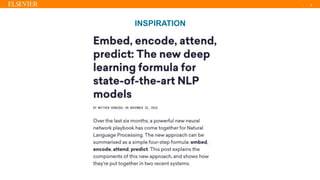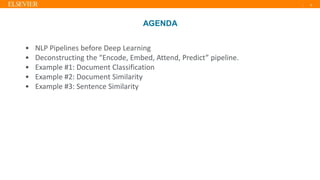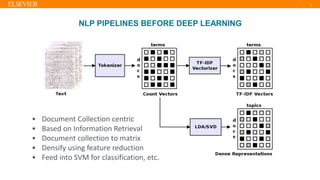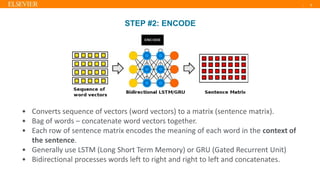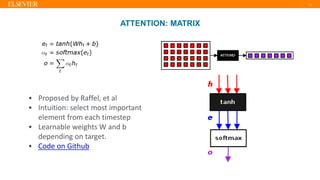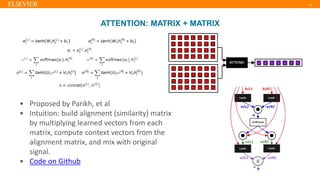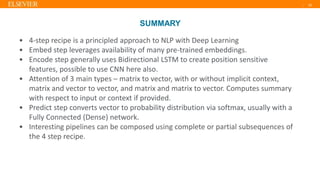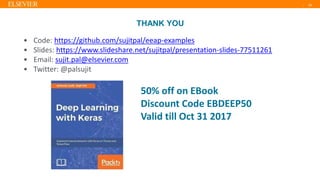Embed, Encode, Attend, Predict – applying the 4 step NLP recipe for text classification and similarity
- 1. | Presented By Date July 6, 2017 Sujit Pal, Elsevier Labs Embed, Encode, Attend, Predict – applying the 4 step NLP recipe for text classification and similarity
- 4. | 4 AGENDA • NLP Pipelines before Deep Learning • Deconstructing the “Encode, Embed, Attend, Predict” pipeline. • Example #1: Document Classification • Example #2: Document Similarity • Example #3: Sentence Similarity
- 5. | 5 NLP PIPELINES BEFORE DEEP LEARNING • Document Collection centric • Based on Information Retrieval • Document collection to matrix • Densify using feature reduction • Feed into SVM for classification, etc.
- 6. | 6 NLP PIPELINES BEFORE DEEP LEARNING • Idea borrowed from Machine Learning (ML) • Represent categorical variables (words) as 1-hot vectors • Represent sentences as matrix of 1-hot word vectors • No distributional semantics at word level.
- 7. | 7 WORD EMBEDDINGS • Word2Vec – predict word from context (CBOW) or context from word (skip-gram) shown here. • Other embeddings – GloVe, FastText. • Pretrained models available • Encode word “meanings”.
- 8. | 8 STEP #1: EMBED • Converts from word ID to word vector • Change: replace 1-hot vectors with 3rd party embeddings. • Embeddings encode distributional semantics • Sentence represented as sequence of dense word vectors
- 9. | 9 STEP #2: ENCODE • Converts sequence of vectors (word vectors) to a matrix (sentence matrix). • Bag of words – concatenate word vectors together. • Each row of sentence matrix encodes the meaning of each word in the context of the sentence. • Generally use LSTM (Long Short Term Memory) or GRU (Gated Recurrent Unit) • Bidirectional processes words left to right and right to left and concatenates.
- 10. | 10 STEP #3: ATTEND • Reduces matrix (sentence matrix) to a vector (sentence vector) • Non-attention mechanism –Sum or Average/Max Pooling • Attention tells what to keep during reduction to minimize information loss. • Different kinds – matrix, matrix + context (learned), matrix + vector (provided), matrix + matrix.
- 11. | 11 ATTENTION: MATRIX • Proposed by Raffel, et al • Intuition: select most important element from each timestep • Learnable weights W and b depending on target. • Code on Github
- 12. | 12 ATTENTION: MATRIX + VECTOR (LEARNED) • Proposed by Lin, et al • Intuition: select most important element from each timestep and weight with another learned vector u. • Code on Github
- 13. | 13 ATTENTION: MATRIX + VECTOR (PROVIDED) • Proposed by Cho, et al • Intuition: select most important element from each timestep and weight it with a learned multiple of a provided context vector • Code on Github
- 14. | 14 ATTENTION: MATRIX + MATRIX • Proposed by Parikh, et al • Intuition: build alignment (similarity) matrix by multiplying learned vectors from each matrix, compute context vectors from the alignment matrix, and mix with original signal. • Code on Github
- 15. | 15 STEP #4: PREDICT • Convert reduced vector to a label. • Generally uses shallow fully connected networks such as the one shown. • Can also be modified to have a regression head (return the probabilities from the softmax activation.
- 16. | 16 DOCUMENT CLASSIFICATION EXAMPLE – ITERATION #1 • 20 newsgroups dataset • 40k training records • 10k test records • 20 classes • Embed, Predict • Bag of Words idea • Sentence = bag of words • Document = bag of sentences • Code on Github
- 17. | 17 DOCUMENT CLASSIFICATION EXAMPLE – ITERATION #2 • Embed, Encode, Predict • Hierarchical Encoding • Sentence Encoder: converts sequence of word vectors to sentence vector. • Document Encoder: converts sequence of sentence vectors to document vector. • Sentence encoder Network embedded inside Document network. • Code on Github
- 18. | 18 DOCUMENT CLASSIFICATION EXAMPLE – ITERATION #3 (a, b, c) • Embed, Encode, Attend, Predict • Encode step returns matrix, vector for each time step. • Attend reduces matrix to vector. • 3 types of attention (all except Matrix Matrix) applied to different versions of model. • Code on Github – (a), (b), (c)
- 19. | 19 DOCUMENT CLASSIFICATION EXAMPLE – RESULTS
- 20. | 20 DOCUMENT SIMILARITY EXAMPLE • Data derived from 20 newsgroups • Hierarchical Model (Word to Sentence and sentence to document) • Tried w/o Attention, Attention for sentence encoding, and attention for both sentence encoding and document compare • Code in Github – (a), (b), (c)
- 21. | 21 SENTENCE SIMILARITY EXAMPLE • 2012 Semantic Similarity Task dataset. • Hierarchical Model (Word to Sentence and sentence to document). • Used Matrix Matrix Attention for comparison • Code in Github – without attention, with attention
- 22. | 22 SUMMARY • 4-step recipe is a principled approach to NLP with Deep Learning • Embed step leverages availability of many pre-trained embeddings. • Encode step generally uses Bidirectional LSTM to create position sensitive features, possible to use CNN here also. • Attention of 3 main types – matrix to vector, with or without implicit context, matrix and vector to vector, and matrix and matrix to vector. Computes summary with respect to input or context if provided. • Predict step converts vector to probability distribution via softmax, usually with a Fully Connected (Dense) network. • Interesting pipelines can be composed using complete or partial subsequences of the 4 step recipe.
- 23. | 23 REFERENCES • Honnibal, M. (2016, November 10). Embed, encode, attend, predict: The new deep learning formula for state-of-the-art NLP models. • Liao, R. (2016, December 26). Text Classification, Part 3 – Hierarchical attention network. • Leonardblier, P. (2016, January 20). Attention Mechanism • Raffel, C., & Ellis, D. P. (2015). Feed-forward networks with attention can solve some long-term memory problems. arXiv preprint arXiv:1512.08756. • Yang, Z., et al. (2016). Hierarchical attention networks for document classification. In Proceedings of NAACL-HLT (pp. 1480-1489). • Cho, K., et al. (2015). Describing multimedia content using attention-based encoder-decoder networks. IEEE Transactions on Multimedia, 17(11), 1875-1886. • Parikh, A. P., et al. (2016). A decomposable attention model for natural language inference. arXiv preprint arXiv:1606.01933.
- 24. | 24 THANK YOU • Code: https://github.com/sujitpal/eeap-examples • Slides: https://www.slideshare.net/sujitpal/presentation-slides-77511261 • Email: sujit.pal@elsevier.com • Twitter: @palsujit 50% off on EBook Discount Code EBDEEP50 Valid till Oct 31 2017


